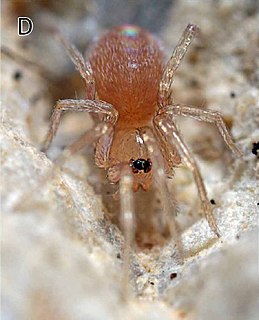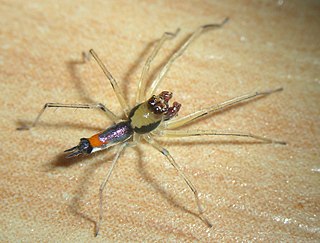
Oonopidae, also known as goblin spiders, is a family of spiders consisting of over 1,600 described species in about 113 genera worldwide, with total species diversity estimated at 2000 to 2500 species. The type genus of the family is OonopsKeyserling, 1835.

Hersiliidae is a tropical and subtropical family of spiders first described by Tamerlan Thorell in 1870, which are commonly known as tree trunk spiders. They have two prominent spinnerets that are almost as long as their abdomen, earning them another nickname, the "two-tailed spiders". They range in size from 10 to 18 mm long. Rather than using a web that captures prey directly, they lay a light coating of threads over an area of tree bark and wait for an insect to stray onto the patch. When this happens, they encircle their spinnerets around their prey while casting silk on it. When the insect is immobilized, they can bite it through the shroud.

Asemonea is a genus of jumping spiders that was first described by Octavius Pickard-Cambridge in 1869.
Festucula is a genus of jumping spiders that was first described by Eugène Louis Simon in 1901.

Archaeidae, also known as assassin spiders and pelican spiders, is a spider family with about ninety described species in five genera. It contains small spiders, ranging from 2 to 8 millimetres long, that prey exclusively on other spiders. They are unusual in that they have "necks", ranging from long and slender to short and fat. The name "pelican spider" refers to these elongated jaws and necks used to catch their prey. Living species of Archaeidae occur in South Africa, Madagascar and Australia, with the sister family Mecysmaucheniidae occurring in southern South America and New Zealand.

Cheiracanthium, commonly called yellow sac spiders, is a genus of araneomorph spiders in the family Cheiracanthiidae, and was first described by Carl Ludwig Koch in 1839. They are usually pale in colour, and have an abdomen that can range from yellow to beige. Both sexes range in size from 5 to 10 millimetres. They are unique among common house spiders because their tarsi do not point either outward, like members of Tegenaria, or inward, like members of Araneus), making them easier to identify. The name is a reference to the backwardly directed process on the cymbium of the male palp. The species epithet is derived from the Greek Ancient Greek: χείρ, romanized: cheir, meaning "hand", and Acanthium, a genus of thorny-stemmed plants.

Hersilia, also known as long-spinnered bark spiders and two-tailed spiders, is a genus of tree trunk spiders that was first described by Jean Victoire Audouin in 1826. Their nicknames are a reference to their greatly enlarged spinnerets.
Garcorops jadis is a possibly extinct species of Wall crab spider, family Selenopidae, and at present, it is one of four known species in the genus Garcorops. The species is solely known from copal found on the beach near Sambava, on the northeast coast of Madagascar.
Leroya is a genus of African crab spiders first described by A. S. H. Lewis & A. S. Dippenaar-Schoeman in 2014. As of April 2019 it contains only two species.

Box kite spiders (Isoxya) is a genus of Afrotropical orb-weaver spiders first described by Eugène Simon in 1885. Like the spiny orb-weavers they have six prominent spines on their abdomen. They are small spiders, measuring 3 to 7 millimetres across. They have a sclerotised abdomen which is typical of the Gastricanthinae.
The Metarbelidae are a family of the Cossoidea also called the carpenter or goat moths, and is sometimes treated as a subfamily, Metarbelinae of the Cossidae. No synapomorphies are shared with the Cossidae based on adult morphology. The family Metarbelidae was first described by Embrik Strand in 1909.

Viridasius is a monotypic genus of East African araneomorph spiders in the family Viridasiidae, containing the single species, Viridasius fasciatus. It was first described by Eugène Simon in 1889, and has only been found in Madagascar.
Murricia is a genus of tree trunk spiders that was first described by Eugène Simon in 1882.
Tyrotama is a genus of African tree trunk spiders that was first described by S. H. Foord & A. S. Dippenaar-Schoeman in 2005.
Africepheia is a monotypic genus of Malagasy araneomorph spiders in the family Synaphridae containing the single species, Africepheia madagascariensis. It was first described by J. A. Miller in 2007, and is found on Madagascar.
Hala is a genus of Malagasy nursery web spiders that was first described by R. Jocqué in 1994. As of June 2019 it contains only two species, found only on Madagascar: H. impigra and H. paulyi.
Hersiliola versicolor is a species of spiders of the family Hersiliidae that lives in Cape Verde. It was first described by John Blackwall in 1865 as Hersilia versicolor. The females have a total length of 3.75-4.58 mm.

Seothyra fasciata, one of the buck spoor spiders, is a sand-dwelling species of Eresidae. It is native to southern Africa.
Madagascarchaea is a genus of assassin spiders first described by H. M. Wood & N. Scharff in 2018.








